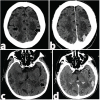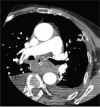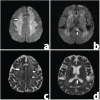COVID-19 related acute necrotizing encephalopathy presenting in the early postoperative period
- PMID: 37293685
- PMCID: PMC10246599
- DOI: 10.22551/2023.39.1002.10246
COVID-19 related acute necrotizing encephalopathy presenting in the early postoperative period
Abstract
Besides respiratory and gastrointestinal symptoms, SARS-CoV-2 also has potential neurotropic effects. Acute hemorrhagic necrotizing encephalopathy is a rare complication of Covid-19. This article presents a case of an 81-year-old female, fully vaccinated, who underwent laparoscopic transhiatal esophagectomy due to gastroesophageal junction cancer. In the early postoperative period, the patient developed persistent fever accompanied by acute quadriplegia, impaired consciousness, and no signs of respiratory distress. Imaging with Computed Tomography and Magnetic Resonance revealed multiple bilateral lesions both in gray and white matter, as well as pulmonary embolism. Covid-19 infection was added to the differential diagnosis three weeks later, after other possible causes were excluded. The molecular test obtained at that time for coronavirus was negative. However, the high clinical suspicion index led to Covid-19 antibody testing (IgG and IgA), which confirmed the diagnosis. The patient was treated with corticosteroids with noticeable clinical improvement. She was discharged to a rehabilitation center. Six months later, the patient was in good general condition, although a neurological deficit was still present. This case indicates the significance of a high clinical suspicion index, based on a combination of clinical manifestations and neuroimaging, and the confirmation of the diagnosis with molecular and antibody testing. Constant awareness of a possible Covid-19 infection among hospitalized patients is mandatory.
Keywords: acute hemorrhagic necrotizing encephalopathy; case report; neuroimaging diagnosis; neurologic manifestations, covid-19; prompt treatment.
Figures






References
Publication types
LinkOut - more resources
Full Text Sources
Miscellaneous
